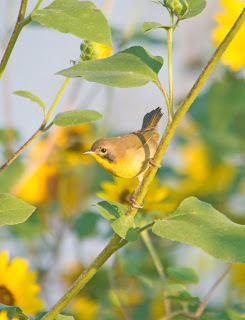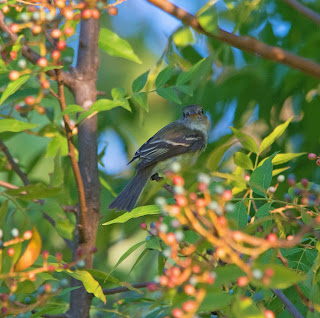Translate
Monday, September 30, 2019
Migration Resurfaces In Higher Gear
Cattle, Egrets, View 1
Cattle Egrets, View 2
Yellow Warbler, View 1
Yellow Warbler, View 2
Yellow Warbler, View 3
092819
0726-0840/77-78 F/mostly cloudy/S-8/79% RH/29.77-29.80 Hg and rising
This was a higher migratory movement day. There were six Blue-winged Teal on the southeast corner lowlands, along with several Mallards, who were coming in the entire time there like a busy airport.
On the water, there were several Pied-billed Grebe and sixteen American Coot.
Observations were also made on a whopping forty-five Cattle Egrets, a few Snowy Egrets, the normal
six Great Egrets, and three Great Blue Herons.
Two non-breeding Forster's Terns were surveying the west side of the lake, and five Spotted Sandpipers were partaking of delectables on the shore of the southwest jetty, along with a Double-crested Cormorant on a snag not far from the jetty on the north side.
Overhead were a couple of southbound Barn Swallows over the water.
To make things interesting, the conservative number of ten Yellow Warblers are now classified as late arrivals by eBird. They were voraciously feeding between the Lakeview Road Bridge and the main path of Shorebird Jetty. There were no doubt more beyond that, as it is now a last minute dash for late birds to return south when they are in a state of Zugunruhe.
A Belted Kingfisher and a Cooper's Hawk also had words, and the size and speed of the kingfisher managed to speak volumes. The hawk had to carry on for breakfast, which was no doubt a young bird wasting time with a healthy kingfisher.
Ten Scissor-tailed Flycatchers were being sociable with each other, along with one that felt it was his duty to chase a Great Egret flying through the area several times. The flycatchers will be with us for another month or so, and if the males still have that much testosterone at this time of year, it could have something to do with all the singing males in flux like they seem to be now. The urge strikes, even though they are not quite ready to move south. It is an interesting concept.
Along with the normal birds for the season, there is no doubt that we are underway on our seasonal changes. There are still a few stragglers, like many warblers, and some likely have an added distance to deal with along with a first time journey. May they experience the best.
Sunday, September 29, 2019
Saturday, September 28, 2019
Migration From Medium to Lower Intensity Over Two Day Period
American Avocet, View 1
American Avocet, View 2
092319
0751-0909/69-72 F/partly cloudy/E-8/84-82% RH/30.01-30.03 Hg and rising
There were still well over four dozen Mallards settled into the low spots at the southeast corner of Boomer Lake. Twenty-Nine Turkey Vultures were riding the thermals over the Boomer Creek area, one Great Egret was at the water's edge wading, two Great Blue Herons were counted as flyovers, an American Coot was in the water, and a Killdeer was heard wailing in the distance.
At The Cove, we had a couple of Mourning Doves on the wing, a yellow-shafted Northern Flicker in the air, an Eastern Phoebe that sat upon a martin house until it tired of the view, a Blue Jay, Carolina Wrens, and a couple of the Northern Cardinal family hiding in the trees on the west side around the sycamores, western soapberry, Bradford pears, and others.
The dozen American Avocets flew up and down Boomer Lake the entire time that I was there, and these were the best shots of them. When they flew from north to south, their height increased, and they pulled closer together the higher that their trajectory became. Then the circling movement came into play and they slowly dropped until the reached about the center of the lake and repeated the process. Once they attempted to land for a moment in the water on the south side of Shorebird Jetty, but soon changed their minds. Perhaps the Great Blue Heron standing in the area on land thwarted their intentions.
An American Crow called from the dam area. and two dozen Double-crested Cormorants were southbound on high. They were likely not planning on resting for a while at the height that they passed through.
Yellow Warbler, View 1
Yellow Warbler, View 2
092419
0832-0923/76-77 F/variable clouds/S-5/86% RH/29.88-29.90 Hg and steady//.16" 24-hour rainfall shortly before dawn
There were slightly fewerMallards today around the lowlands on the southeast corner of the lake with a half dozen Blue-winged Teal in tow.
Two Barn Swallows made their way south, and on the water we had two Canada Geese, a Pied-billed Grebe, three Great Egrets, and a Great Blue Heron.
At The Cove a Nashville Warbler was in the company of eight Yellow Warblers, all partaking of sunflower seeds and insects, which by the way, over the past two weeks held up well with the onslaught.
Monday, September 23, 2019
Sunday, September 22, 2019
Post Rain Boomer Birding
Yellow Warbler
Female Eastern Downy Woodpecker
Blue-winged Teal
092219
1055-1217/77-78 F/variable to mostly cloudy/SSW-13/87-86% RH/29.88 Hg and steady
After an overnight rain of 2.73", a little activity was observed on Heron Cove. A male Wilson's Warbler was singing, which proves that with adult males, even though they are migrating, summer is not over yet and testosterone is still coursing in their veins. However, Zugunruhe provides migratory restlessness. A photo was not possible due to the rapid movements, even though the male was at eye level. It could have been a good shot.
The Wilson's was in the company of several Yellow Warblers, all having breakfast after a wet night. Insects were on the menu, as migration depletes the body's resources.
A resident female Eastern Downy Woodpecker was also in the area on snags, also in search of protein sustenance. An Eastern Bluebird was heard on the west side of The Cove.
The southeastern low field of Boomer Lake around the pecan trees and mulberry hosted a little over a dozen Canada Geese, 85 migratory Mallards, and a couple dozen juvenile Blue-winged Teal. A couple of Barn Swallows (migrants) and resident Mourning Doves passed overhead.
The remainder of the day remained cloudy and more rain came late afternoon. Perhaps tomorrow will prove fruitful, too.
Thursday, September 19, 2019
Wilson's Warbler Is a Common Fall Migrant in Oklahoma
Wilson's Warbler
091719
0728-0835/75-78 F/partly cloudy/SSE-3/78-76%/29.98-29.97 Hg and steady
After having caught a glimpse of this bird on Saturday, 091419, It was again observed on Monday, 092319, which was a much better look.
It was heard before it was spotted this date, so my intent was to stick for a photo, since the warbler had been used to finding me in the area. The hunch paid off that it would do so, and even though it is a rapid mover, my luck came through. It was observed in a sycamore, and the rest is history.
This was the last day that it was here, apparently continuing on its southern trek. It was last spotted by writer on 091918. Most of these fast moving birds winter in Central America.
Tuesday, September 17, 2019
Warbler and Monarch Central On Boomer Lake
Yellow Warbler
Juvenile Male Common Yellowthroat
Ditto, View 2
Monarch Butterfly on
Sunflower
The Yellow Warblers have been on Boomer Lake for the past two weeks and have been far reaching, spending much of their time around willows, sunflowers, Bradford pears, sycamores and many other woody stemmed native plants. Monarchs have been in the area of nectar giving plants, clustering around sunflowers, along with many of the lepidoptera, like swallowtails.
The juvenile male Common Yellowthroat is a warbler and has been in the midst of the Yellow Warblers around the sunflowers on the northern and western side of Heron Cove. This area tends to be a warbler and general songbird magnet due to the native deciduous trees that attract beneficial insects.
Monday, September 16, 2019
Boomer Lake's Soon-to Be Migrant and a Later Resting Migrant
Immature Mississippi Kite
082719
0805-911/76-77 F/variable to partly cloudy/N-8/81-80% RH/29.96-29.94 Hg and rising
This was about ten days before the kites left for their South American wintering grounds. My last observation of an adult was on 091019. Even at the time of this photo, this immature bird was still begging for food. The adults let it beg, as it was old enough to find its own.
Kites usually nest near or even have a wasp's nest within it, which could protect the young from climbing predators. Smaller birds also nest nearby and coexist peacefully. However, if one injects a human in the picture, the adult kites are very territorial with parental duties, and unless the person is wearing a hat, his scalp could well be scraped by those talons.
Great Blue Heron
090119
9745-0926-71-77 F/partly cloudy/E-1/84-83% RH/30.05-30.11 Hg and rising
This lovely adult in breeding plumage was on the last southern jetty just north of Goose Island. It calmly permitted this photo and with the backlighting, provided a nice accent.
Possible Least Flycatcher
View 2
09-01-19
0745-0926/71-77 F/partly cloudy/E-1/86-80% RH/30.07 Hg and rising
Definitive ID of this empidonax species was not possible, but it is believed that this is the Least Flycatcher. Most adults in fall are silent, but it would give occasional "piks."
Sunday, September 15, 2019
Sunday, September 8, 2019
Monday, September 2, 2019
Sunday, September 1, 2019
Subscribe to:
Posts (Atom)




















